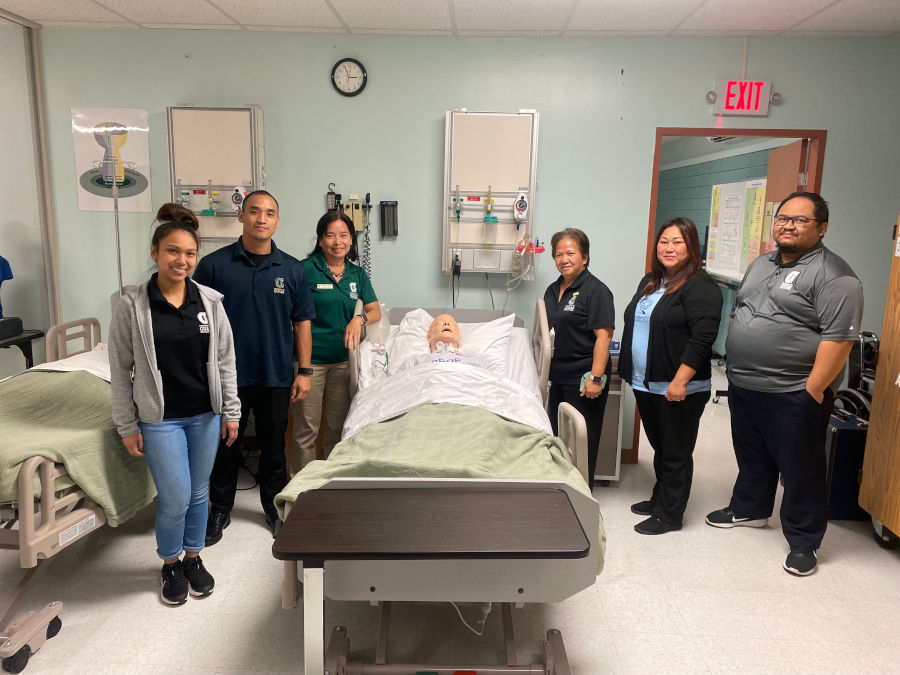Partnership between UOG, health-care facilities helps fill labor gap
Partnership between UOG, health-care facilities helps fill labor gap
Partnership between UOG, health-care facilities helps fill labor gap
11/16/2022

The University of Guam’s partnership with island health-care facilities for a Certified Nursing Assistant apprenticeship program has opened new career paths for some and is helping to fill a labor shortage on the island.
Funded by the Department of Labor, the apprenticeship program collaborates with the Guam Regional Medical City, the Guam Memorial Hospital Authority, Catholic Social Services, and Health Services of the Pacific.
CNA apprentices are required to complete 100 hours in the classroom and lab, 60 clinical hours, and continued apprentice hours based on agreements between the Labor Department and employers.
“It’s almost a seamless process for [students] to slide right from apprentice into an actual full-time employee,” said Dean Margaret Hattori-Uchima with the UOG Margaret Perez Hattori-Uchima School of Health. The apprenticeship allows students to get paid while training to be a CNA. Additionally, federal funds cover several instructional costs, such as tuition, books, supplies, training materials, uniforms, and certifications.
For Jennifer Poll, her apprenticeship proved to be life changing. Poll has worked with GRMC as a certified nursing assistant since 2019. She previously pursued a CNA career path while attending Southern High School. For years, Poll worked a string of service industry jobs to help support her family, especially her three children. In search of a better job, Poll decided to pursue the apprenticeship.
‘Now I have a career’
“This is really a calling for me. I really did pray for this, and now I have a career,” Poll said. “I am so happy to be a CNA. And I’m glad for this program, and thankful for GRMC and the faculty that helped us here,” she added.
Some students in the program were unable to pursue a higher education full time due to work schedules, parenthood, and other family responsibilities. Others were displaced workers from different fields who decided to make a career change.
“[This program] is a career ladder and an introduction to health care,” CNA instructor Veronica “Vicky” Alave said. The program takes a lot of dedication, and students need to be “very much alert and awake” to attend classes three times a week, which often take place in the late afternoon, evenings, and Saturdays, she added.
The program launched in 2019.
At the time, UOG’s Margaret Perez Hattori-Uchima School of Health was the only DOL-funded, health-care training facility to develop a CNA apprenticeship program.
Hattori-Uchima strove to meet the deadline to submit a five-year, $750,000-per-annum federal workforce grant that ultimately was awarded to the Margaret Perez Hattori-Uchima School of Health to fund the program.
GRMC is the CNA program’s first acute-care apprenticeship partner with its first batch of eight students. The hospital donated patient beds for the training.
“This program was one of the first few collaborative efforts by us and UOG to open up the medical career pathway for Guam and, in turn, for GRMC,” said Charlotte Huntsman, GRMC senior vice president of Human Resources & Organizational Development.
Addressing a labor shortage
Hattori-Uchima recalled there was a severe CNA shortage at the height of the pandemic.
To alleviate the shortage, the apprenticeship transformed into a condensed, hybrid program in which prospective certified nursing assistants underwent training at both GRMC, GMHA, and HSP.
Three batches later, 36 apprentices have completed the program.
